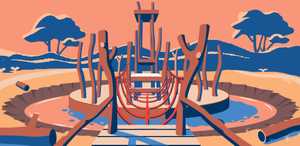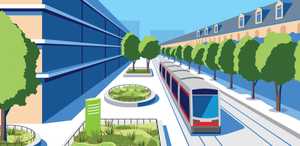Urbanism / Global
Happy space
City dwellers pine for attractive and usable spaces; city planners are beginning to take note. We visit the places where poetic verses are daubed on streets, statues of dogs add a dose of whimsy and ‘playable pavements’ allow children to let off steam.

01
Madrid’s pavements
Greener and more literate
Under the cover of night four years ago, Boa Mistura, an acclaimed troupe of street artists, brightened the mood of Madrid’s commuters by stencilling 33 poetic verses onto pedestrian crossings. Manuela Carmena, who was sworn in as the city’s unlikely mayor a few months later, has since embraced a similarly playful approach to urbanism.
From the outset of her time in office, the septuagenarian’s agenda included a pledge to make the city “more amiable”. One of her earliest interventions was to remove hostile spiked iron railings around two fountains in Puerta del Sol. “We came into power looking at large paved areas lacking any green space and individual public seating designed to repel the homeless,” says José Manuel Calvo, Madrid’s councillor for sustainable urban development. “But this meant friends, couples and families were also prevented from sitting together.”
Fast-forward a few years and mayor Carmena’s policies have prompted a sweeping revival of the city’s streets. Madrileños might have grumbled through a cacophony of jackhammers and harried construction but the work has paid off. The century-old Gran Vía has been transformed from a congested boulevard to a place to rest and socialise. More than 110 stone benches and 33 modular wooden recliners designed by architect Marcos Plazuelo sit on widened footpaths lined with 89 trees. The road is now not only a major transport artery but an attractive place to mingle.
Councillor Calvo has embraced Madrid’s gregarious character where others had sought to rein it in. “A friendly city means urban design for all, regardless of age or physical condition,” he says. Adding more trees will improve wellbeing because “breathing uncontaminated air always helps to improve a city’s mood”. Six plazas next to Gran Vía will soon become parks, offering Madrileños further green space in which to relax.
A city-centre restriction on non-residential traffic, which has come into force after years of delays, will provide further impetus to reimagine the public realm. And what of Boa Mistura? Mayor Carmena invited the street artists to continue their once-illicit activities and daub poetic verse onto Madrid’s streets, this time with the city’s financial blessing. They can even use permanent paint.

02
Child-friendly Rotterdam
Universal design at play
“People can inhabit anything – and they can be miserable in anything and ecstatic in anything,” said Rem Koolhaas. But in 2006, the architect’s native city hosted the Netherlands’ unhappiest children, according to a survey. Industrial Rotterdam was the country’s poorest urban centre. Housing stock was low quality and space was scarce despite the city’s reputation for architectural innovation.
“We began mapping the problems using the new possibilities of open data,” says Sandra de Bont, a landscape architect on the city’s urban-planning team. “We wanted to have a child’s perspective in the front of our minds every time we made plans for neighbourhoods or streets.” This approach has long been championed by Rotterdam’s mayor Ahmed Aboutaleb. “He always emphasises how important it is that young people grow up in a city they like,” says De Bont.
Bike paths have been prioritised over parking spaces and “playable pavements” at least 3 metres wide have been built on the sunny sides of streets. Roof Park Rotterdam has brought playgrounds, themed gardens, a barbecue area and dancing water fountains to the top of a new waterside retail park in Delfshaven. Speeldernis nature playground in the city centre occupies the site of a former playground known as de botte spijker (the blunt nail). Director Ian Mostert says the playground fosters the independent play that boosts a child’s development. “Kids are encouraged to understand risk for themselves,” he says. “They develop their social skills and learn how to set their own boundaries using all of their creativity and imagination in contact with nature.”
Since 2006, Rotterdam has spent €15m upgrading its public spaces. The biggest change so far has been the regeneration of nine disadvantaged neighbourhoods into “promising areas” by building houses and improving schools. The city’s council hoped that “the average number of affluent families will increase by 10 per cent”. Marguerite van den Berg of Amsterdam University’s Institute for Social Science Research says these families are considered to be “the silver bullet that will solve a variety of urban problems. Children and parents are a focal point of gentrification policies.” The droomstraaten (dream streets) initiative has also encouraged residents to contribute. Mustapha Ziani and his four children took part in the €53,000 overhaul of Ruilstraat. Locals planted shrubs and staffed pop-up cafés. “Everyone who participated feels a sense of pride,” says Ziani. “Teenagers keep the street clean and tidy. My kids spend more time playing outside.”

03
Bandung’s novel public square
Art accommodating life
“Heads, shoulders, knees and toes, knees and toes.” Indonesian children in brown uniforms are led through an anatomical nursery rhyme by their teacher before their morning lessons begin. The exercise is part of a 30-minute workout in a public square in Bandung, a city of 2.5 million that is 160km southeast of Jakarta. A teacher concludes the singing and stretching and watches the children run amok among sculptures, clambering up the steps of a pavilion and crawling under seating.
This is Cicendo plaza, a scrapyard-turned-community space that also boasts a basketball court, skate park, art market and amphitheatre. Mothers gather to chat and elderly men conduct their morning stretches. There is even a spot for an indulgent reflexology massage: visitors take off their shoes and walk over stones. The plaza is sandwiched between low-income and middle-class neighbourhoods. Walls have been erected on two sides of the corner plot to shield the site from noisy traffic.
Public open spaces are rare in Indonesia’s busy and heavily privatised cities. Cicendo plaza is the third such project initiated by former mayor Ridwan Kamil, a former architect who is now governer of West Java, the archipelago’s most populous province. The project he began aims to reinstate the leafy squares that were once common in urban Indonesia. “This is a society where people are learning to use public spaces for the first time,” says Daliana Suryawinata, the co-founder of Shau, the Bandung-based architecture firm that designed the space. “Indonesia is 40 – if not 100 – years behind many developed cities in terms of public infrastructure. We are learning from doing.”
Cicendo plaza’s topography unfolds on multiple levels. Steps lead down to the art market and up to the elevated decking. This landscaping is reminiscent of the rice terrace tiers that can be seen in the countryside. Tropical legumes arachis pintoi (pinto peanuts) add a vibrant shade of green to the sculptures that sit atop six plinths. The inspiration for this “accessible art” from the Kröller-Müller Museum, the sprawling sculpture garden in the Dutch village of Otterlo.
It was in the Netherlands that Suryawinata met her German husband and business parter Florian Heinzelmann.“On the weekends the park is full,” says Heinzelmann, who grew up near Munich. “I have never seen that in Europe, ever. People here are really craving public spaces and the number of activities they are engaging in is dazzling.”

04
Toronto’s golden bone
Whimsy for dogs and humans
Toronto isn’t a city known for the playfulness of its public spaces but the golden bone atop the Victorian-styled, cast-iron fountain in Berczy Park could be a sign that things are changing. Staring hungrily up at the bone are a boxer, a St Bernard and some pugs: hand-painted statues with jets of water spraying from their mouths, which converge gracefully at the fountain’s apex.
The somewhat absurd fountain is the centerpiece of the recently renovated park, as conceived by landscape architect Claude Cormier on a tight triangular plot on the east side of Toronto’s downtown. The original park was well used but it was also dull. Cormier wanted to demonstrate what a touch of whimsy and wonder could do for a city, especially in a busy, mixed-use neighbourhood rapidly becoming denser with office workers and condo residents. “We wanted to bring some magic to the space,” says Cormier. “It’s not about being pretentious or stylistically heavy handed. Our goal was to create something playful and timeless by being conceptually strong.”
Infusing a sense of fun into urban spaces has been a signature of Cormier’s 14-person studio since it launched in 1995. He is best known for his “Pink Balls” installation in Montréal, a kilometre-long canopy of plastic spheres hung over Sainte-Catherine Street. One of the most-loved (or, in some cases, most-loathed) additions to Toronto’s waterfront revitalisation is “Sugar Beach”, a delightful faux-urban beach of white sand and oversized candy-pink umbrellas designed by Cormier.
Despite the success of “Sugar Beach”, Toronto’s authorities were initially reluctant to approve Cormier’s plans for Berczy. “They probably worried it was going to be tacky,” he says. “What did dogs have to do with art or landscape architecture?” Having already won the support of local stakeholder groups, Cormier convinced city staff by showing them historical depictions of dogs in art, such as William H Beard’s “The Dog Congress”. They also cited hand-painted dog figurines produced by German toymaker Schleich, after which Cormier’s team modelled Berczy’s dogs. His fountain opened in 2017 to much local fanfare.
Cormier’s approach is to never think of a street as just a street, or a park as just a park. “It’s about creating a mise-en-scène,” he says. “We’re making a stage where people can act on a daily basis, where part of what makes a place enjoyable is watching and being watched.” Cities, he adds, could generally use more moments of theatre and doses of whimsy. Why not – as in this case – make dogs a part of the action?

05
Vienna’s miniature parks
Good things in small packages
Since 2007, Vienna has sought to reinvigorate the overall concept for its 950 parks – ranging from the curlicued Baroque gardens of Schönnbrunn Palace and the Belvedere to lovely corners in the Stadtpark – while also creating brand new microparks in the once-fallow corners of the city’s districts. The positive effects of large parks are well documented but nature can boost happiness even in small pockets. These tiny spaces bring unexpected cheer to the urban landscape. “A few years ago we began to use the little corners on the streets – everywhere where it makes sense – to enliven the city,” says Margit Grassinger of the City Parks Department.
The municipal department manages the bigger picture but each of Vienna’s 23 districts has its own budget for flowers, trees and seating. Squares in front of churches might sport “summer flora”, while smaller areas use a combination of evergreen plants to add life to interstitial spots. “The reaction has been very, very positive,” says Grassinger, who views the city’s role in making people happy as a matter of course. Other creatures benefit too. “There’s a lot happening in these small areas, even in terms of ecology – a lot of small animals live here as well.” The microparks host some of the one million red tulips that are planted across the city every spring; come summer they are replaced with wheatgrass and purple gladioli. For the curious, some of the gardens contain signs to identify the species on display. Many of the flowers are bought from local nurseries and all are cared for by 950 gardeners.
But the microparks do not only provide a refuge for flowers and rodents: Vienna’s humans can also find outdoor seating, tables and even red-rope hammocks. “The idea was to offer seating beyond the usual park benches,” says Grassinger. “We looked at young people and they usually don’t sit on benches but put their feet up, so we have a range.” Chairs in tiny plots on busy pavements offers the city’s older residents a place to rest when tired.
While the proliferation of microparks in Vienna is a relatively recent phenomenon, the inspiration may come from a decades-old project. Developed in the mid-1980s by a group of gardening students, Therese-Sip-Park is an oasis beside Linke Wienzeile, a busy thoroughfare on the north bank of the River Wien. Trees, hedges and blooms protect the park from the noise of the traffic and surround two tables around which sets of chairs are arranged, creating the impression of a living room. “It’s intensively used,” says Grassinger.


